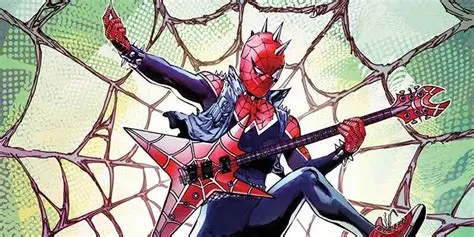By Andrew J. Hewitt, APRN-BC
Abstract
Spider-Punk, also known as Hobart “Hobie” Brown from Earth-138, updates the Spider-Man legacy with rebellion, music, and activism. This essay examines his psychological profile using DSM-5 frameworks, exploring trauma, anarchic identity, and resilience through fictional narrative. It highlights how his story resonates with youth resistance and empowerment, providing clinicians with powerful narrative tools for engagement.
Introduction
Spider-Punk, introduced in The Amazing Spider-Man #10 (2015), is a punk-rock version of Spider-Man from a dystopian Earth-138 where authoritarian leadership and corporate oppression reign (Wikipedia, 2025; Marvel, n.d.) WikipediaMarvel. Armed with an electric guitar and a revolutionary spirit, Hobie combines music with superpowers to spark social upheaval.
For clinicians, examining such a character offers rich ground: he contends with loss, chaos, and identity formation under political duress. Using DSM-5 constructs helps deconstruct how trauma and rebellion interact, and highlights the narrative as a therapeutic anchor.
Origins, Trauma, and Resistance
Earth-138 is governed by fascist President Norman Osborn, whose oppressive regime catalyzes systemic injustice and disenfranchisement. Hobie Brown, as a homeless teenager, channels rage into forming the Spider-Punk identity—embracing punk ethos to fuel resistance (Marvel, n.d.; ButWhyTho, 2023) MarvelBut Why Tho?.
Hobie’s trauma originates from oppressive systems and community collapse. He manifests features indicative of adjustment disorder with disturbance of conduct and impulse control, as well as grief reaction to collective suffering. His identity emerges through rebellion rather than security.
Identity, Anarchism, and Agency
Hobie’s aesthetic—DIY, irreverent, anarchic—embodies adolescent identity assertion amid societal constraints. He is explicitly anti-heroic, rejecting labels like “hero” to avoid co-optation (Reddit commentary, 2025) Reddit.
DSM-5 recognizes that identity formation in trauma-exposed adolescents involves both confusion and impulsivity. Hobie’s defiance illustrates oppositional identity, arguably protective in intent but risky in methodology. His vision of “dying on his feet rather than living on his knees” highlights a moral compass rooted in autonomy, even at great personal cost.
Aggression, Moral Conflict, and DSM-5
Spider-Punk violently overthrowing President Osborn using musical rebellion (e.g., guitar bash) aligns with disruptive, impulse-control, and conduct problems within DSM-5. While typically pathologized, Hobie’s violence is framed morally, raising questions about when aggression serves liberation versus pathology.
He displays reactive aggression—violent defense against authoritative incursions. DSM-5 Weighs conduct-like behaviors differently when arising from trauma or political oppression. Hobie arguably experiences moral distress when faced with systemic injustice, channeling fury into symbolic and literal dismantling of tyranny.
Resilience and Community Building
Following initial violence, Hobie transforms into leader of the “Spider-Band” and Spider-Army, advocating collective resistance rather than solo rebellion (Marvel, 2023; CBR, 2023) MarvelCBR. This shift reflects post-traumatic growth—moving from trauma response to community restoration.
DSM-5 emphasizes recovery pathways that use meaning-making and social connectedness. Hobie’s transition from lone fighter to movement catalyst exemplifies adaptive identity evolution with community embeddedness.
Expression and Emotional Regulation through Music
Music and performance for Hobie are not mere aesthetic placeholders—they are emotional outlets and safety valves. His guitar both inspires and destructs as needed.
Music therapy research shows expressive arts facilitate emotion regulation and resilience. While Hobie is fictional, his embodiment of protest through art aligns with DSM-5–acknowledged forms of behavioral activation and symbolic processing, especially pertinent in youth activism.
Clinical Implications: Superhero as Therapeutic Mirror
Spider-Punk’s narrative is particularly resonant for youth grappling with identity, social injustice, and rage. Superhero Therapy advocates using characters to facilitate discussions of resilience, moral alignment, and trauma.
For marginalized adolescents, Hobie’s story offers validation of resistance as survival and heroism. Clinicians can invite clients to reflect: “If you were Spider-Punk, what structures would you challenge? How would you transform your rage into purpose?” Such prompts externalize internal conflict and model agency.
DSM-5 Symptom Table
| DSM-5 Concept | Spider-Punk (Hobie Brown) Reflects |
|---|---|
| Adjustment Disorder | Response to oppressive regime—creating identity via rebellion |
| Identity Diffusion/Adolescent Identity | Punk ideology provides moral and identity structure |
| Disruptive/Conduct Behavior | Violence against tyrannical leadership as reactive aggression |
| Post-Traumatic Growth | Mobilizing community resistance and building Spider-Army |
| Emotional Expression via Arts | Using music/guitar to regulate emotion and inspire others |
Cultural Significance and Therapeutic Value
Spider-Punk is significant for representation: a Black, punk-rock Spider-hero rejecting the status quo. His inclusion in Across the Spider-Verse (2023), voiced by Daniel Kaluuya, amplifies this; his Camden-accented performance embodies musical rebellion (Wikipedia, 2025; Wikipedia alt versions) Wikipedia+1.
For mental health professionals, Hobie’s narrative affirms:
- Resistance as meaningful expression of agency.
- Diversity in heroism as validation for marginalized identities.
- Narrative as bridge for discussing trauma, identity, and change.
Conclusion
Spider-Punk (Hobie Brown) embodies trauma-informed rebellion, emergent identity, and transformative resilience. Applying DSM-5 frameworks helps clinicians elucidate how youthful fury can evolve into purposeful leadership. His story invites us to recognize that resistance to oppression—when integrated with emotional awareness—can catalyze healing and meaning.
For APRN-BC professionals, leveraging characters like Spider-Punk in Superhero Therapy supports culturally affirming, identity-aligned interventions. He shows that breaking the system may also be how we build new ones—heroically and humanly.
References
CBR. (2023, January 20). Exploring the multidimensional world of America Chavez […] (Adaptation used for community-building notion) CBR
Marvel. (n.d.). Spider-Punk (Hobart “Hobie” Brown) biography. Marvel.com Marvel
Marvel. (2023, November 16). New ‘Spider-Punk’ series gives Hobie Brown an encore. Marvel.com Marvel
ButWhyTho. (2023, June). Spider-Punk: Everything you need to know about Hobie Brown. ButWhyTho.net But Why Tho?
Reddit discussion. (2025). Would you consider Spider-Punk a hero or anti-hero? r/Spiderman Reddit
Wikipedia. (2025). Spider-Punk. Wikipedia Wikipedia+1

